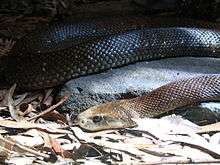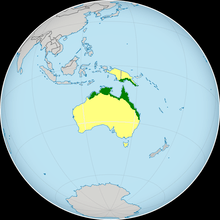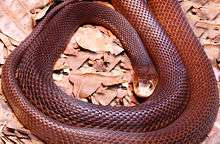Coastal taipan
The coastal taipan (Oxyuranus scutellatus), or common taipan,[2] is a species of large, extremely venomous snake in the family Elapidae. The species is native to the coastal regions of northern and eastern Australia and the island of New Guinea. According to most toxicological studies, this species is the third-most venomous land snake in the world after the Inland taipan and Eastern brown snake based on its murine LD50.[3][4]
| Coastal taipan | |
|---|---|
 | |
| Scientific classification | |
| Kingdom: | Animalia |
| Phylum: | Chordata |
| Class: | Reptilia |
| Order: | Squamata |
| Suborder: | Serpentes |
| Family: | Elapidae |
| Genus: | Oxyuranus |
| Species: | O. scutellatus |
| Binomial name | |
| Oxyuranus scutellatus | |
 | |
| Distribution of Oxyuranus scutellatus in green | |
| Synonyms[1] | |
Taxonomy
German naturalist Wilhelm Peters described the coastal taipan as Pseudechis scutellatus in 1867.[5]
Two subspecies are recognized as being valid, including the nominotypical subspecies.
| Subspecies[6] | Taxon author[6] | Common name | Geographic range |
|---|---|---|---|
| Oxyuranus scutellatus canni | Slater, 1956 | Papuan taipan | Throughout the southern portion of the island of New Guinea[7] |
| Oxyuranus scutellatus scutellatus | (W. Peters, 1867) | coastal taipan | Australia: coastal Queensland, northern parts of Northern Territory and the northeastern parts of Western Australia[8] |
Description
The coastal taipan is the longest venomous snake in Australia.[9] Adult specimens of this species typically attain sexual maturity around 1.2 m (3.9 ft) in total length (including tail). More mature specimens can grow to between 1.5 and 2.0 m (4.9 and 6.6 ft). Other taipans, including the inland taipan, attain broadly similar sizes although they tend to be slightly smaller in average size. A specimen of an average 2 m (6.6 ft) total length weighs around 3 kg (6.6 lb).[10] According to the Queensland Museum, the longest recorded total length for the coastal taipan was a specimen that was 2.9 m (9.5 ft) and weighed 6.5 kg (14 lb).[9] However, though exceptionally rare, much larger specimens are widely believed to exist, including specimens of as much as 3.3 m (11 ft).[11] The taipan is exceeded in length among venomous snakes only by the Asiatic king cobra, African black mamba, and genus Lachesis (bushmasters) of the American neotropics.
The head of the coastal taipan is long and narrow like that of the African black mamba (Dendroaspis polylepis), but without the "coffin" shape. The two species are strongly convergent in several aspects of morphology, ecology and behaviour.[8] O. scutellatus has an angular brow and is lighter-coloured on the face. The body is slender and colouration can vary.[12] It is often uniformly light olive or reddish-brown in colour, but some specimens may be dark gray to black. The colouration is lighter on the sides of the body, and the ventral side (the belly) is usually a creamy-white to a pale light yellow in colour, and is often marked with orange or pink flecks. Individuals undergo a seasonal change in colour, becoming darker in winter and fading in summer.[13] The eyes are large, round, and are light brown or even hazel in colour with large pupils.[12][14]
Scalation
The number and arrangement of scales on a snake's body are key elements of identification to species level.[15] The temporals are 2+3 (3+4). The dorsal scales are in 21-23 rows at mid-body. The ventrals number 220–250. The anal plate is single (undivided). The subcaudals number 45–80 and are divided.[16]
Distribution and habitat
The coastal taipan occurs in Australia and the island of New Guinea, which comprises two Indonesian provinces on the west side of the island and the nation of Papua New Guinea on the east side of the island.
Found in northern and eastern Australia, the coastal taipan, despite its name, can live in habitats hundreds of kilometres away from the nearest beach. Its geographical range extends from north-western Western Australia, the Northern Territory, across Cape York Peninsula and down eastern Queensland into northern New South Wales (as far south as Grafton).[12] However, the coastal taipan is not found in regions where the maximum winter temperature is below 20 °C (68 °F).[8] The second subspecies (Oxyuranus scutellatus canni ) is found throughout the island of New Guinea, with higher concentrations of the snake being found in the nation of Papua New Guinea.[7]
Habitat
The coastal taipan can be found in a variety of different habitats. It can be found in warm, wetter temperate to tropical coastal regions, in monsoon forests, wet and dry sclerophyll forests and woodlands, and in natural and artificial grassy areas, including grazing paddocks and disused rubbish tips.[7][17] In Queensland, it has adapted well to sugarcane fields, where it thrives on the rodent population in the fields. In Far North Queensland in the Cape York Peninsula, it is usually found in open woodland areas.[12] Thickets of introduced Lantana are also favoured habitat. The coastal taipan shelters in abandoned animal burrows, hollow logs, and in piles of vegetation and litter.[17]
Behaviour and diet
The coastal taipan is primarily diurnal, being mostly active in the early to mid-morning period, although it may become nocturnal in hot weather conditions. When hunting, it appears to actively scan for prey using its well-developed eyesight, and is often seen traveling with its head raised slightly above ground level. Once prey is detected, the snake "freezes" before hurling itself forward and issuing several quick bites. The prey is released and allowed to stagger away. This strategy minimizes the snake's chance of being harmed in retaliation, particularly by rats, which can inflict lethal damage with their long incisors and claws.[18] It is not a confrontational snake and will seek to escape any threat. When cornered, though, it can become very aggressive and may strike repeatedly.[17]
Diet
The coastal taipan's diet consists entirely of rats, mice, bandicoots, and various species of birds.
Venom

Oxyuranus scutellatus is the world's third-most venomous terrestrial snake. The SC LD50 value of this species is 0.106 mg/kg, according to Australian Venom and Toxin database,[4] and 0.12 mg/kg, according to Engelmann and Obst (1981). The average venom yield per bite is 120 mg,[19] with a maximum record of 400 mg.[4]
Its venom contains primarily taicatoxin, a highly potent neurotoxin affecting the nervous system and the blood's ability to clot. Bite victims may experience headache, nausea/vomiting, collapse, convulsions, paralysis, internal bleeding, myolysis (destruction of muscle tissue), and kidney damage.[13][20] In cases of severe envenomation, death can occur as early as 30 minutes after being bitten, but the average is around 2.5 hours. The time between a bite and death depends on various factors such as the nature of the bite and the constitution of the victim.[20] Untreated bites have a mortality rate of 100% as the coastal taipan always delivers a fatal dose of venom (an average bite delivers 10-12x the lethal dose of venom for a human adult male), and medical professionals recommend that victims seek immediate medical attention even for apparently minor bites. Before the introduction of specific antivenom by the Commonwealth Serum Laboratories in 1956, nearly all bites were fatal.[13][20][21]
In his book Venom, which explores the development of a taipan antivenom in Australia in the 1940s and 1950s, author Brendan James Murray argues that only one person is known to have survived an Oxyuranus bite without antivenom: George Rosendale, a Guugu Yimithirr aboriginal bitten at Hope Vale in 1949. Murray writes that Rosendale's condition was so severe that nurses later showed him extracted samples of his own blood that were completely black in colour.
References
- "Oxyuranus scutellatus (PETERS, 1867)". The Reptile Database. Retrieved 16 February 2012.
- "CSL Taipan Antivenom". CSL Antivenom Handbook. www.toxinology.com. Retrieved 7 December 2011.
- Ernst, Carl H.; Zug, George R. (1996). Snakes in Question: The Smithsonian Answer Book. Washington, District of Columbia, USA: Smithsonian Institution Scholarly Press. ISBN 1-56098-648-4.
- Thomas, Séan; Griessel, Eugene (Dec. 1999). "LD50". Archived from the original on February 1, 2012.CS1 maint: multiple names: authors list (link)
- Peters, Wilhelm (1867). "Über Flederthiere und Amphibien". Monatsberichte der Königlich Preussischen Akademie der Wissenschaften zu Berlin (in German): 703–12 [710–11].
- ITIS
- O'Shea, Mark (1996). A Guide to the Snakes of Papua New Guinea. Port Moresby, Papua New Guinea: Independent Publishing Group. 251 pp. ISBN 981-00-7836-6.
- Shine R, Covacevich J (1983). "Ecology of highly venomous snakes: the Australian genus Oxyuranus (Elapidae)". Journal of Herpetology. 17 (1): 60–69. doi:10.2307/1563782. JSTOR 1563782.
- "FAQ: Snakes". Australian Venom Research Unit. University of Melbourne. Retrieved 7 December 2011.
- "Archived copy". Archived from the original on 2007-07-16. Retrieved 2012-12-19.CS1 maint: archived copy as title (link)
- "Oxyuranus scutellatus - General Details". Clinical Toxinology Resource. University of Adelaide. Retrieved 17 April 2012.
- "Coastal Taipan". Queensland Museum. Retrieved 17 April 2012.
- "Coastal Taipan".
- Hoser RT (May 2002). "An overview of the taipans, genus Oxyuranus (Serpentes: Elapidae) including the description of a new subspecies". Crocodilian - Journal of the Victorian Association of Amateur Herpetologists. 3 (1): 43–50.
- Hutchinson, Mark; Williams, Ian (2018). "Key to the Snakes of South Australia" (PDF). South Australian Museum. Government of South Australia. Archived from the original (PDF) on 18 July 2019. Retrieved 8 February 2019.
- "Devenomized - Oxyuranus scutellatus" (PDF). Devenomized. Archived from the original (PDF) on 25 April 2012. Retrieved 17 April 2012.
- "Animal Species: Coastal Taipan". Australian Museum. Retrieved 17 April 2012.
- Wilson, Steve; Swan, Gerry (2011). A Complete Guide to the Reptiles of Australia. Australia: New Holland Publishers Pty. Ltd. 558 pp. ISBN 978-1-877069-76-5.
- Engelmann, Wolf-Eberhard (1981). Snakes: Biology, Behavior, and Relationship to Man. Leipzig; English version NY, USA: Leipzig Publishing; English version published by Exeter Books (1982). pp. 222. ISBN 0-89673-110-3.
- "IMMEDIATE FIRST AID for bites by Australian Taipan or Common Taipan".
- Brown JH (1973). Toxicology and Pharmacology of Venoms from Poisonous Snakes. Springfield, Illinois: Charles C. Thomas. pp. 184. ISBN 0-398-02808-7. LCCN 73-229.
Further reading
| Wikispecies has information related to Oxyuranus scutellatus |
| Wikimedia Commons has media related to Oxyuranus scutellatus. |
- Barnett, Brian (1999). "Keeping and Breeding the Coastal Taipan (Oxyuranus scutellatus)". Journal of the Victorian Herpetological Society 10 (2/3): 38–45.
- Boulenger GA (1896). Catalogue of the Snakes in the British Museum (Natural History). Volume III., Containing the Colubridæ (Opisthoglyphæ and Proteroglyphæ) ... London: Trustees of the British Museum (Natural History). (Taylor and Francis, printers.) xiv + 727 pp. + Plates I-XXV. (Pseudechis scutellatus, pp. 331–332).
- Murray, Brendan James (2017). Venom: The heroic search for Australia's deadliest snake. Australia: Echo Publishing. 442 pp.
- Williams, David (January 2004). "The Death of Kevin Budden". David Williams' Australian Herpetology Online.